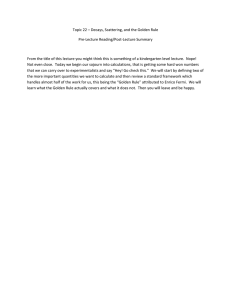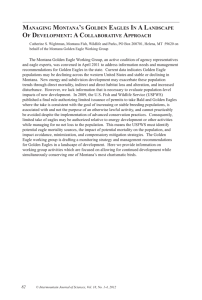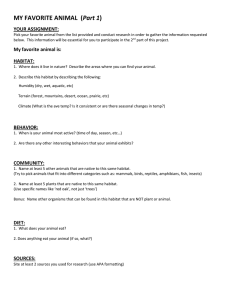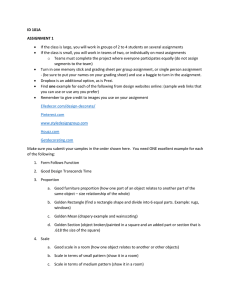AQCH Text
advertisement
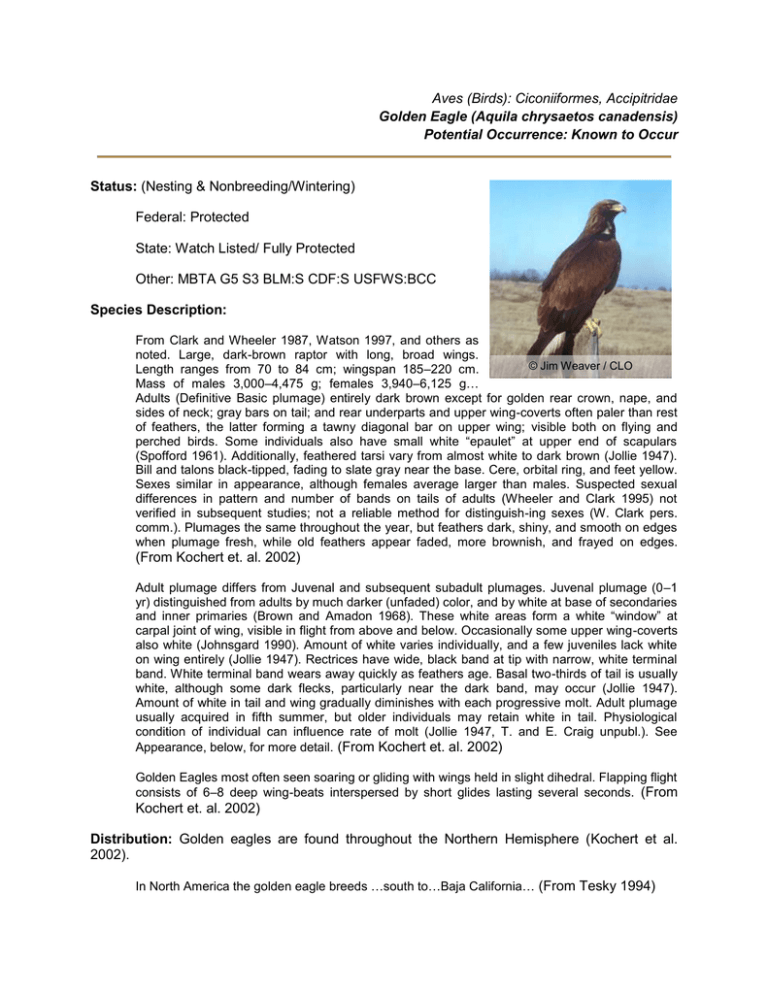
Aves (Birds): Ciconiiformes, Accipitridae Golden Eagle (Aquila chrysaetos canadensis) Potential Occurrence: Known to Occur Status: (Nesting & Nonbreeding/Wintering) Federal: Protected State: Watch Listed/ Fully Protected Other: MBTA G5 S3 BLM:S CDF:S USFWS:BCC Species Description: From Clark and Wheeler 1987, Watson 1997, and others as noted. Large, dark-brown raptor with long, broad wings. © Jim Weaver / CLO Length ranges from 70 to 84 cm; wingspan 185–220 cm. Mass of males 3,000–4,475 g; females 3,940–6,125 g… Adults (Definitive Basic plumage) entirely dark brown except for golden rear crown, nape, and sides of neck; gray bars on tail; and rear underparts and upper wing-coverts often paler than rest of feathers, the latter forming a tawny diagonal bar on upper wing; visible both on flying and perched birds. Some individuals also have small white “epaulet” at upper end of scapulars (Spofford 1961). Additionally, feathered tarsi vary from almost white to dark brown (Jollie 1947). Bill and talons black-tipped, fading to slate gray near the base. Cere, orbital ring, and feet yellow. Sexes similar in appearance, although females average larger than males. Suspected sexual differences in pattern and number of bands on tails of adults (Wheeler and Clark 1995) not verified in subsequent studies; not a reliable method for distinguish-ing sexes (W. Clark pers. comm.). Plumages the same throughout the year, but feathers dark, shiny, and smooth on edges when plumage fresh, while old feathers appear faded, more brownish, and frayed on edges. (From Kochert et. al. 2002) Adult plumage differs from Juvenal and subsequent subadult plumages. Juvenal plumage (0–1 yr) distinguished from adults by much darker (unfaded) color, and by white at base of secondaries and inner primaries (Brown and Amadon 1968). These white areas form a white “window” at carpal joint of wing, visible in flight from above and below. Occasionally some upper wing-coverts also white (Johnsgard 1990). Amount of white varies individually, and a few juveniles lack white on wing entirely (Jollie 1947). Rectrices have wide, black band at tip with narrow, white terminal band. White terminal band wears away quickly as feathers age. Basal two-thirds of tail is usually white, although some dark flecks, particularly near the dark band, may occur (Jollie 1947). Amount of white in tail and wing gradually diminishes with each progressive molt. Adult plumage usually acquired in fifth summer, but older individuals may retain white in tail. Physiological condition of individual can influence rate of molt (Jollie 1947, T. and E. Craig unpubl.). See Appearance, below, for more detail. (From Kochert et. al. 2002) Golden Eagles most often seen soaring or gliding with wings held in slight dihedral. Flapping flight consists of 6–8 deep wing-beats interspersed by short glides lasting several seconds. (From Kochert et. al. 2002) Distribution: Golden eagles are found throughout the Northern Hemisphere (Kochert et al. 2002). In North America the golden eagle breeds …south to…Baja California… (From Tesky 1994) The golden eagle winters … south throughout the breeding range to Mexico,.. (From Tesky 1994) Uncommon permanent resident and migrant throughout California, except center of Central Valley. Perhaps more common in southern California than in north. Ranges from sea level up to 3833 m (0-11,500 ft) (Grinnell and Miller 1944)…(From Zeiner et.al. 1990) Life History & Threats: Golden eagles are sexually mature at 4 or more years of age [16]…The golden eagle breeding season generally occurs from mid-January to mid-September, but varies according to geographic area [22,27]…. The golden eagle lays one to three eggs, with two eggs most common [9,21,27]. The eggs are incubated for 35 to 45 days [9]… Nestlings fledge at 9 to 10 weeks and remain in the vicinity of the nest. The parents provide food for the fledglings until they are about 14 weeks old or older [9]…Migration varies with population and cohort and is a function of both food supply and climate. … In the mountainous West, golden eagles often move down from the mountains onto the plains and valleys during the winter [8]. Breeding golden eagles prefer to maintain their nesting-hunting territories or travel the shortest distance necessary to survive prolonged cold or heat, while older prebreeders may be less tied to specific locations. Birds of the youngest cohort are often migratory… Golden eagles in captivity have lived 41 to 48 years, but it is unlikely that many live that long in the wild [9]. (From Tesky 1994) Activity Patterns: Yearlong, diurnal activity. (From Zeiner et.al. 1990) Seasonal Movements/Migration: Mostly resident, but may move downslope for winter, or upslope after breeding season. Some migrate into California for winter. (From Zeiner et.al. 1990) Home Range: Home range probably same as territory. Size of home range related to prey density and availability, and openness of terrain. (From Zeiner et.al. 1990) Territory: …124 km2 (48 mi2) in northern California (Smith and Murphy 1973). (From Zeiner et.al. 1990) Reproduction: Breeds from late January through August; peak in March through July. Clutch size 1-3, usually 2. Eggs laid early February to mid-May. Incubation 43-45 days (Beebe 1974), and nestling period usually 65-70 days. (From Zeiner et.al. 1990) Niche: Occasionally preys on domestic calves and lambs. May compete with ferruginous hawks for small mammals, and with California condors for carrion. May desert nest in early incubation if disturbed by humans (Thelander 1974). (From Zeiner et.al. 1990) Direct and indirect human-caused mortality, disturbance, and the elimination of prey by habitat alteration are the main factors limiting golden eagle populations [28]. Shooting, poisoning, trapping, electrocution and/or collision with powerlines, and pesticide contamination have all been identified as causes of the decline of golden eagle populations. In addition, recreational activities may disturb breeding, wintering, and migration activities, disrupting and often reducing the population [9]. (From Tesky 1994) Declined in early 1900s due to eradication campaigns, frequently encouraged by the use of bounties (eagle was believed to be a major predator on livestock). Extremely susceptible to powerline electrocution because wings can span phase-to-phase or phase-to-ground wires (Biosystems Analysis 1989); modifications have been made in problem areas. Other threats include poison intended for coyotes, occasional shootings, and habitat loss to agriculture and suburban land uses. (From NatureServe 2009) Habitat & Habitat Associations: General Habitat: The golden eagle inhabits open country from barren areas to open coniferous forests. They are primarily in hilly and mountainous regions… In California the golden eagle favors grasslands, shrublands with tree saplings, and open-canopy blue oak (Quercus douglasii) woodlands. (From Tesky 1994) Across w. U.S., prefers open habitats with native vegetation and avoids urban, agricultural, and forested areas (Millsap 1981, Fischer et al. 1984, Craig et al. 1986, Marzluff et al. 1997). Uses sagebrush communities, riparian areas, grasslands, and rolling oak savanna (Knight et al. 1979, Fischer et al. 1984, Hayden 1984, Estep and Sculley 1989). (From Kochert et al 2002) Secluded cliffs with overhanging ledges and large trees used for cover… Uses rolling foothills and mountain terrain, wide arid plateaus deeply cut by streams and canyons, open mountain slopes, and cliffs and rock outcrops. (From Zeiner et al. 1990) Foraging Habitat: Needs open terrain for hunting; grasslands, deserts, savannahs, and early successional stages of forest and shrub habitats…Occasionally searches from a perch and flies directly to prey (Carnie 1954). (From Zeiner et. al. 1990) The golden eagle generally forages in open habitats where rabbits and small rodents are available. During the nesting season the golden eagle usually forages within 4.4 miles (7 km) of the nest [7]. Trees, live or dead, are often used for perches if they are near open areas where prey can be easily seen [30]. (From Tesky 1994) Nesting Habitat: Nests on cliffs of all heights and in large trees in open areas. Alternative nest sites are maintained, and old nests are reused. Builds large platform nest, often 3 m (10 ft) across and 1 m (3 ft) high, of sticks, twigs, and greenery. Rugged, open habitats with canyons and escarpments used most frequently for nesting. (From Zeiner et. al. 1990) The golden eagle nests on cliff ledges, preferably overlooking grasslands; 10 to 100 feet (3-30 m) above ground in dead or live trees; in artificial structures; or on the ground [8,7,27]… Golden eagles are most likely to use trees for nesting if cliff sites are unavailable. (From Tesky 1994) In central California, nests primarily in open grasslands and oak (Quercus spp.) savanna and to a lesser degree in oak woodland and open shrublands (Hunt et al. 1995, 1999). (From Kochert et. al. 2002) Roosting Habitat: During nesting season, both males and females have preferred perches near nest (Bergo 1987); female often roosts at nest during nesting season (Collopy 1984). ... roosting on prominent perches with good views of the landscape; usually perches above nest site but below ridge during nesting season (Watson 1997). During nonnesting season, both members of resident pair… prefer sunny aspect in winter and avoid windy, exposed locations (From Kochert et.al. 2002) Conceptual Basis for GIS Model Development: The entire Study Area is habitat for this species. To identify habitats with specific types of use by Golden Eagles, we mapped: Foraging Habitat: All vegetation types with < 40% canopy cover, including: open drainages (i.e., bare ground. In the Study Area, bare ground is identified in the GIS layer as occurring only along scoured creeks and drainages) grasslands chaparral (i.e, mixed chaparral and scrub oak). Note that for chaparral vegetation, the Calveg classification characterizes all chaparral with 0% canopy cover. cismontane woodland. This includes oak dominated woodlands (i.e., Valley oak (Quercus lobata), Canyon live oak (Quercus chrysolepsis), Interior live oak (Quercus wislizeni), Oregon white oak (Quercus garyana), Blue oak (Quercus douglasii), Coast live oak (Quercus agrifolia). Mixed and montane mixed woodlands with the appropriate canopy cover were also mapped: we determined through field reconnaissance that mixed woodlands often include significant numbers of oaks. coniferous forest Possible best foraging habitat in the above vegetation types was mapped as: all areas in the above habitat types with canopy cover < 20% Nesting/Roosting Habitat: Large trees (> 61 cm (24 in) DBH) Cliffs Potential Occurrence in the Galbreath Wildlands Preserve: Protection status for this species applies to nesting and non-breeding individuals. Habitat: While Golden Eagles can be found in almost any habitat type on the North Coast, they prefer open vegetation types for hunting and cliffs and large trees for roosting and nesting. Habitat quality for foraging, nesting, and roosting is moderate to good (Figure 72). Open habitats preferred by this species for foraging occur are relatively abundant and occur along Rancheria Creek, in grasslands, and areas of open mixed oak woodland generally running north-south in the center of the Preserve. Nesting and roosting habitat is also relatively abundant but not optimal. Cliffs are preferred nesting and roosting locations for this species. Based on field reconnaissance, cliffs generally occur along ridgelines and are easily accessible by potential predators. Large tress and snags are of higher quality and patchily distributed throughout the Preserve. Note that while snags are not available for mapping in the GIS database, logging of the Preserve was discontinued in 2000 and large snags are common. Nearest Occurrence: Documented Occurrences in Preserve: This species has not been documented in the Preserve. To our knowledge, no surveys have been conducted. Nearest Occurrence to Preserve: This species has not been reported to occur in USGS quads adjacent to the Preserve. Summary: We anticipate this widespread species is “Likely to Occur” in the Preserve due to the relative abundance of moderate to good quality foraging, nesting and roosting habitat. References Kochert MN, Steenhof K, Mcintyre CL, Craig EH. 2002. Golden Eagle (Aquila chrysaetos), The Birds of North America Online (A. Poole, Ed.). <http://bna.birds.cornell.edu/bna/species/684>. 2010 July 21. NatureServe. 2009. NatureServe Explorer: An online encyclopedia of life [web application]. Version 7.1.<http://www.natureserve.org/explorer>. 2010 July 21. Tesky JL. 1994. Aquila chrysaetos. In: Fire Effects Information System. <http://www.fs.fed.us/ database/feis/>. 2010 July 21. Zeiner DC, Laudenslayer WF, Mayer JE Jr., and White M, eds. 1988-1990. California's Wildlife. Vol. I-III. Sacramento: California Depart. of Fish and Game. Species Account Description: Linden Schneider and Emily Harvey
